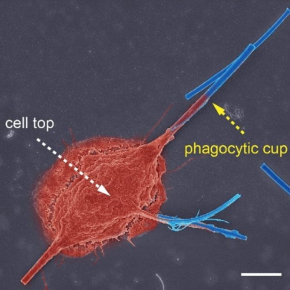
Asbestos: the size and shape of inhaled nanofibres could be exclusively responsible for the development of pulmonary fibrosis
The pathogenic potential of inhaling the inert fibrous nanomaterials used in thermal insulation among other uses (such as asbestos, glass nanofibres or carbon nanotubes, etc.) is actually connected not to their chemical composition, but instead to their geometrical characteristics and size. This was revealed by a study, published on 3 January 2024 in the journal Nature Nanotechnology, conducted on glass nanofibers by a French-Chinese team including a CNRS chemist.1
The reason for this is the inability of the macrophages2 naturally present in pulmonary alveolar tissue to eliminate foreign bodies that are too large. The study was initially conducted in vitro with electrochemical nanosensors, and revealed that when confronted with inert nanofibers over 15 microns in length,3 the cells are unable to distend enough to entirely encapsulate them within their “digestive” vesicle. This results in leaked secretions that are very harmful for the alveolar walls, which this study detected, characterised, and quantified for the first time.4 An experiment on rats subsequently showed that regular unprotected inhalation of similar inert fibrous nanometerials, whatever they may be, causes repeated pulmonary lesions that can eventually lead to the development of fibroma.
This discovery poses a challenge for the use of inert nanofibres in certains sectors, which had heretofore been deemed to be less harmful than the asbestos it replaced.

©Yu-Ting Qi et al., 2023, Nature Nanotechnology.

©Yu-Tin Qi et al., 2023, Nature Nanotechnology.
- 1From the Selective Activation Processes via Uni-Electronic or Radiative Energy Transfer Laboratory (CNRS/ École normale supérieure – PSL/Sorbonne Université), in collaboration with Wuhan University.
- 2“Big eater” cells belonging to groups of white blood cells whose primary role is to eliminate cell debris and pathogenic biological agents throughout the body.
- 3Or 0.015mm, a micron measuring 10-3 mm.
- 4The ROS and RNS species (species reactive to oxygen and nitrogen) secreted by macrophages are known for attacking the bioorganic components of healthy cells, and cause inflammation and mutations that are often cancerous. While the phenomenon of “frustrated phagocytosis” had already been observed, its role in the pathogenesis of the concerned diseases had not yet been clearly established.
ROS/RNS Leakage During Frustrated Phagocytosis of Glass Nanofibers Characterized by Nanosensor and its Implications on Lung Injury. Yu-Ting Qi, Fu-Li Zhang, Si-Yu Tian, Hui-Qian Wu, Yi Zhao, Xin-Wei Zhang, Yan-Ling Liu, Pingqing Fu, Christian Amatore, and Wei-Hua Huang. Nature Nanotechnology, January 3, 2024.

